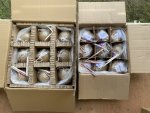As promised in my previous post here is what happened when the containers arrived at export customs in China. Much to our surprise there was no mention of the 1.1G/1.3G 6 inch shell issue. I can only assume that the lab results from the shipping company inspection were accepted. Instead the containers were refused for export because the fireworks were from a different province than the one they were being exported through. With the help of a factory from the province of export we were able to negotiate the export of the containers after about a week of delay. We had heard about a similar export policy in another province but not in the province we were exporting through. This is another example of the unstable situation of fireworks regulation in China.
In my opinion the regulatory difficulties in China are not specific to fireworks. The Chinese government will take action with no concern for industry or the supply chain if it wants to do something. They have been trying to reduce injuries and deaths in industry and stop corruption. They have been jailing or executing people for corruption when there has been an industrial accident caused because the officials were looking the other way due to corruption. I think this is resulting in officials scrambling to make sure everything under their watch is within regulations when they feel the attention is on them.
The result of the latest action on 6" and 8" shells is that the 25% flash powder rule from the Default Fireworks Classification Table is being applied in China. This result is good as shipping and storing 1.1G material as 1.3G could result in a terrible accident. The bad side is the way China introduces new regulatory measures is disruptive and expensive for industry.
The Dunpai Blog post referred to by Fuse
says "An “investigation team” of technocrats". Technocrats by their nature look at the technical aspects of a problem and try to solve it by the best technical solution. From what I see the technical solution they are looking at is the UN Fireworks Default Classification Table. The UN Fireworks Default Classification Table classifies fireworks by analogy to existing fireworks designs. Here link to the table.
The link to the table is to an Australian government website. There is nothing specifically Australian about the table. It was just the 1st website that I found that had the table by itself, not buried in a much larger document.
The table was developed by the United Nations Economic Commission for Europe unece.org.org
It is used by most European countries, Great Britain, Australia, Canada and most other developed countries but not by the USA.
Both China and the USA participated in the developing the Table but at the present time both countries do not use the table and it has no legal status in the USA or China.
There was lots of fireworks science done in many countries to develop the table including the CHAF project where they blew up whole containers of fireworks to see what classification they should be.
Here is a quick explanation of fireworks classifications
1.4s no significant effect outside the packaging
1.4G no significant projection of fire beyond 5 meters
1.3G major fire hazard minor explosion hazard
1.1G instantaneous Mass explosion
To arrive at these results there are specific tests UN series 6 tests that involve containment, witness screens, witness plates and ignition methods that are described in the prescriptions for UN6a, UN6b, and UN6C tests.




